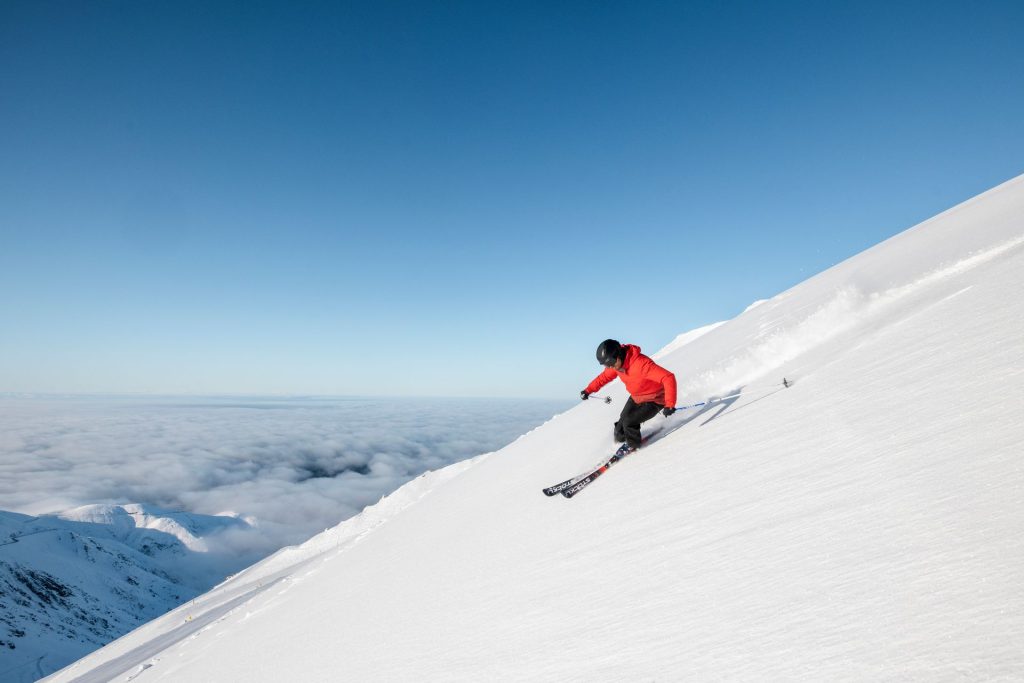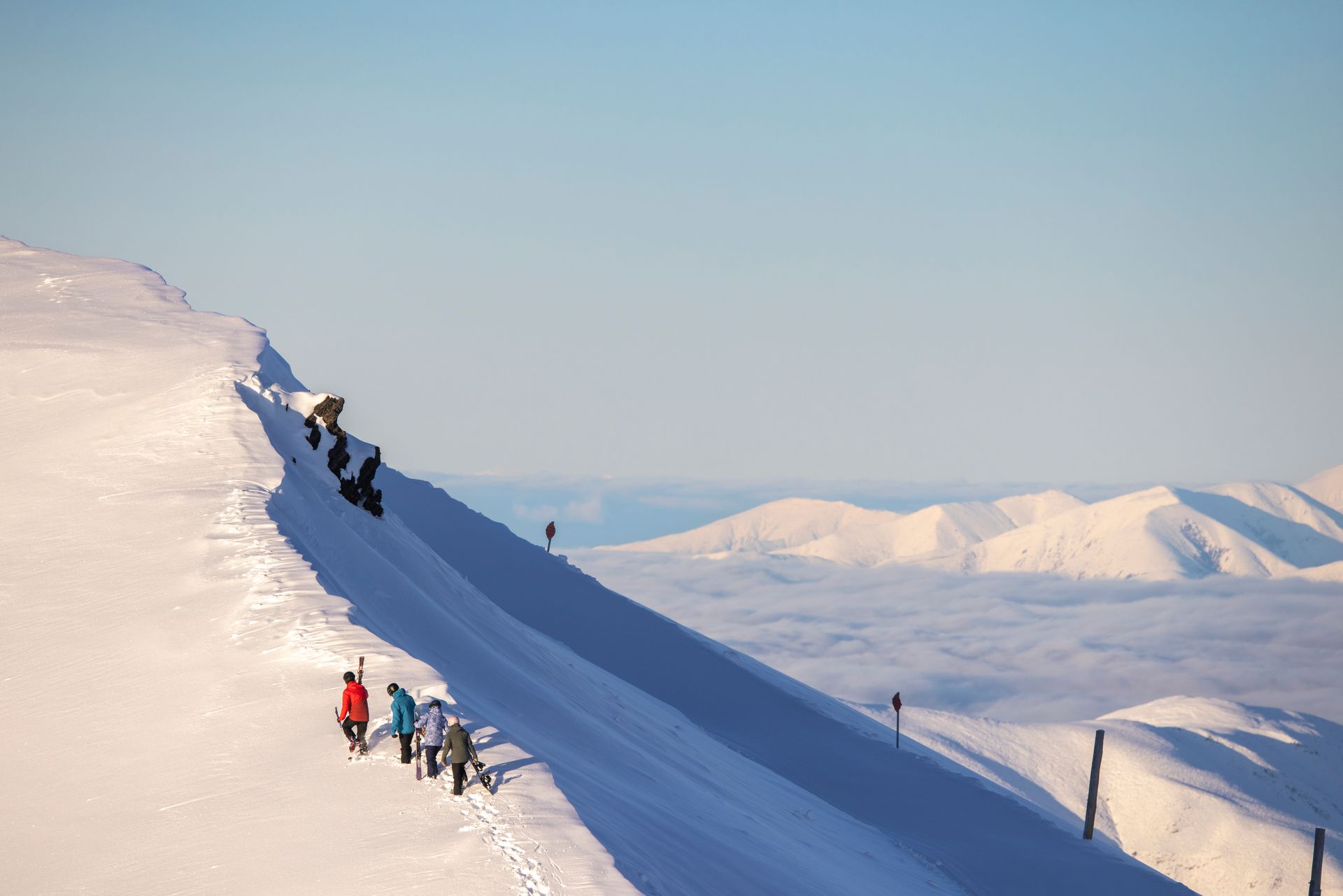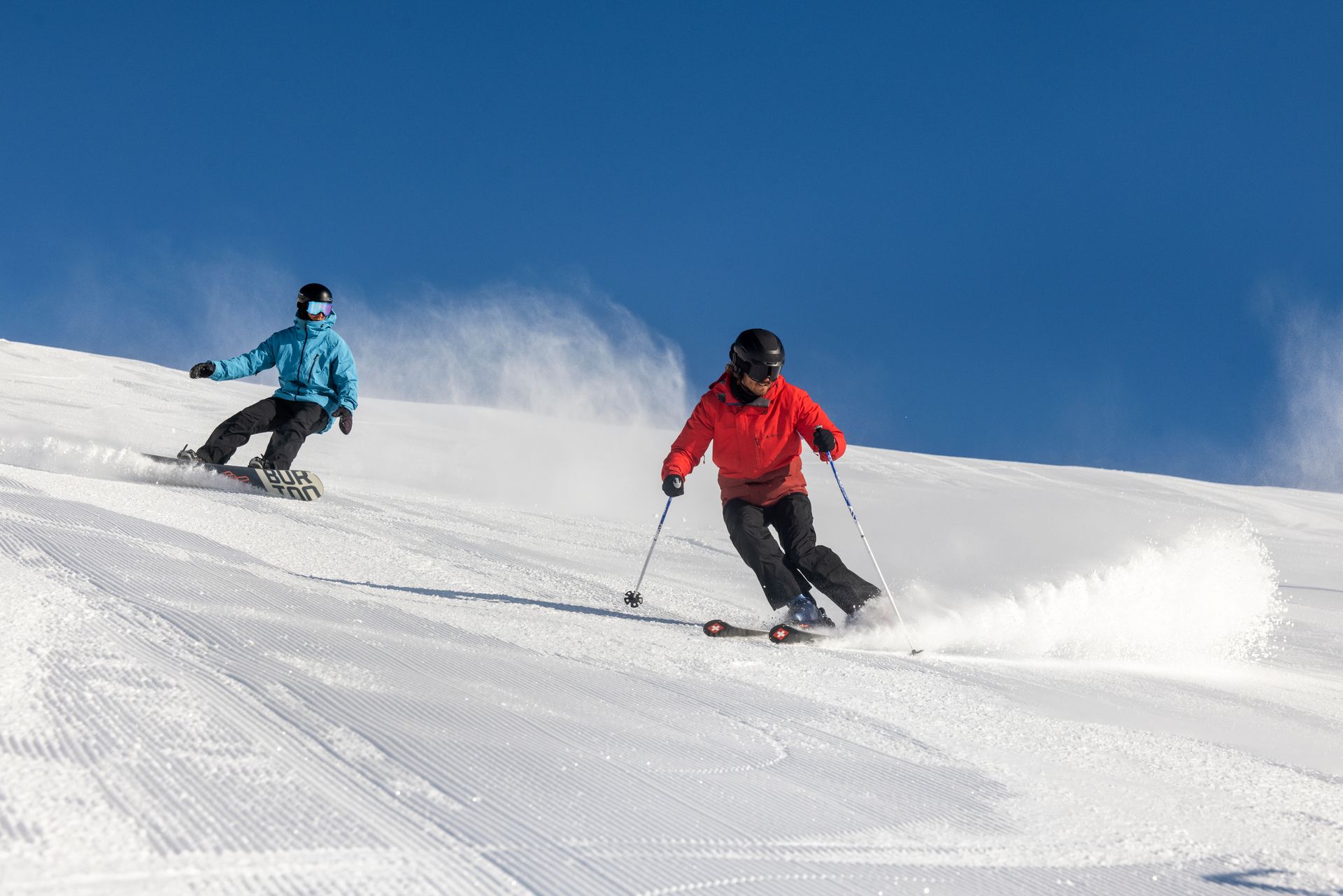For an alien paying a visit to earth, witnessing a group of humans going ski touring would (if they had any shadow of a doubt) confirm suspicions that we are absolutely mad. It involves attaching planks of wood to our feet, walking them uphill in zig zigs, stopping (a lot) to adjust gear, and finally, skiing down.

It’s mad, and anyone who’s into ski (or alpine) touring tends to be mad about it – for good reason. It’s absolutely awesome. Fresh untouched snow, no crowds, and the unbeatable hush of the mountains – what’s not to love? People have been backcountry skiing for centuries, but until recently, it was more a form of transport than adventure.
The earliest known ski tourers were the Norwegians back in 1555, before one of their own, Norwegian ‘Snowshoe Thompson’ made a name for himself in the 1800’s in California. He would deliver mail to miners over the Sierra Navada mountains, embarking on hectic five day missions in aid of delivering his sack.
These days, a ski tour is in the name of recreation, for the most part. For anyone who enjoys skiing in a ski resort but craves true, out of bounds and into the wild adventure, it’s a damn good time. New Zealand is the perfect alpine playground to explore in winter, too, with plenty of options on offer for the first timer to the seasoned ski mountaineering pro.

What does ski touring mean?
Ski (or alpine) touring is essentially backcountry skiing, where you’re skiing in unpatrolled, unmarked areas. It combines uphill ascents, traversing and downhill skiing. A quick way to spot people on a ski tour mission, apart from the fact that they’re heading up the mountain, is their free heels. When traversing or ascending, the heels can come away from the ski, allowing for a gliding motion.
As you may imagine, you need a lot of equipment. There’s nothing between you and the mountains, and you need to be equipped. There are skis, bindings and boots specific to backcountry skiing, which allow you to switch between uphill and downhill mode, whilst being as light weight possible. Then there are the climbing skins (which literally used to be fawn skins when they were at it in Norway years ago), and which are stuck onto the bottom of your skis for grip when it’s time to start ascending.

Is ski touring hard?
With the variety of mountain terrain in New Zealand, there’s certainly entry-level, easier missions to practice on, but as you progress, it does get trickier and more technical. The late Gottlieb Braun-Elwert, a well-known New Zealand mountaineer and skier, compared the practice to a symphony.
‘A ski traverse is like a well composed piece of music. It flows with harmony, surprises with the unexpected. It engages all your emotions and the melody lingers in your mind afterwards. Good music needs players who are masters of their instruments.’
It’s energy intensive, too – lugging touring equipment (or ‘instruments’) to the top of a mountain multiple times is a fantastic way to get fit.
One of the biggest things to take into consideration when going into the backcountry, whether you’re ski touring or ski mountaineering, is avalanche safety. It’s not something you would want to take chances with. They’re powerful, dangerous things and the mountains are an unforgiving and unpredictable place, particularly in winter.
Always make sure you’ve done enough safety training for where you want to go, have the right safety equipment and have checked the avalanche safety report.
What is the difference between ski touring and telemark?
It’s all in the bindings. With alpine touring, the bindings are set up so you can switch between having your heel ‘locked in’ for downhill, and ‘free’ for going up. For telemark skiing, the heels are always free, so you basically lunge into every turn with your front knee bent.
Telemark is pretty niche, but if you’re doing it right, it looks very cool – can’t you just see yourself slow lunging your way from the top of a mountain?
What is the difference between ski touring and classic cross country skiing?
While ski touring varies in the steepness of the mountains you’ll climb up and ski down, cross country skiing tends to be on more rolling terrain. The skis are long and skinny, and cross country can be done both parallel style or skate style.
What do I need for ski touring?
When you’re heading out into the backcountry, you want to be well prepared, from your snacks to your safety gear, and of course your choice of ski boot. When it comes to your gear setup, the lighter the better, because you’re replacing the chairlift with elbow grease to get yourself to the top. In other words, you’re earning your turns.
You’ll find that backcountry skiing boots will be much lighter than alpine (downhill) ski boots, using cool top of the range technology like lightweight carbon fibers. They also have ‘walk mode’, which gives you a better range of motion for walking when the time comes. Many touring boots fit into specific ski touring bindings, too – which brings us to the skis.
The skis have different bindings to downhill skis, too, and let skiers clip their heels in and out (more on these later). While technically any skis could be used, there are definitely certain characteristics you want for the backcountry. Ideally, light skis are best, but with enough waist width to support you through fresh snow on your descent, and to get an edge in for traversing across steep sections.
Then we come to the skins. Climbing skins, which used to literally be made of fawn skin, and then seal hides, are now thankfully synthetic or mohair. They have a seriously sticky underside, which you stick down to the bottom of your skis, and you’re set to ski uphill. Onwards and upwards!
Even if your setup is dialed, you can’t go out into the backcountry without proper avalanche safety gear. The minimum is a transceiver, shovel and probe, but many people have avalanche airbags, personal locator beacons and other more sophisticated gear.
In New Zealand, many people go for a few days, staying in backcountry huts high in the mountains for the night. It can be hard going, and the conditions can change fast, so it pays to bring extra warm clothes and food in case anything happens. Regardless, every ski tour mission needs at least one bag of scroggin (Kiwi speak for trail mix).
How do ski touring bindings work?
Ah, welcome to the wonderfully complex world of backcountry ski equipment. The touring ski binding comes in a few different forms. First, the pin (or tech) binding. These lightweight bad boys have long been a go-to for backcountry skiers – even as little as half a pound may make a difference on a big mission. They have metal prongs that fit into holes in a tech binding specific ski boot. They’re great on weight, and easy to use, but offer less stability on the downhill, especially in powder or on ice.
Enter frame bindings, which are less light, but with epic downhill performance. They allow for heel lift when walking, and much more stability when cutting turns, but can feel clunkier than the tech variety. Great for beginners, and for those who are going to spending as much time around the resort as putting in a skin track.
How do you choose touring skis?
Depends what you’re going to be doing. If you’re an aggressive downhill skier and want to spend your days chasing thick winter powder, you’ll want wider underfoot – think around 90-115mm. But, if you’ll be doing mostly spring skiing or long tours where thick snow isn’t the aim of the game, narrower skis will make your ascents and traverses far more nimble.
Should touring skis be shorter?
Only if you’re planning on racing or doing more uphill than downhill – otherwise, the length should be what you’re used to skiing inbounds.
Do you need special boots for ski touring?
Yes, although these days you can get hybrid boots, which can fit into both frame and alpine bindings. That means you don’t have to buy two pairs for winter – the one can used for both backcountry missions and resort days.
How do I choose a touring boot?
The best thing to do is go and try some on, and talk to your local boot specialist. Think about the type of skiing you’re going to be doing this winter – if you’ll be hitting lots of big uphills and spending most of your time in the backcountry, a lighter, backcountry-specific boot is the way to go. If popping out the side of the resort for a few backcountry laps is more your thing, go for a burlier hybrid boot that’ll give you the most stability as you carve your way downhill.
How should touring boots fit?
On a day out skiing the backcountry, your feet are your best friend, and the first thing you want to do is make sure they’re happy. To do this, it’s best to find the right boots that fit well, so you’re kept warm and saved from blisters or more serious damage. When you go and try boots on, you’ll be looking to find your overall foot sizing, the shell fit and the liner fit. The width is just as important as the length, and you’ll want to try out walk and ski mode, too.
Even though a snug fit is ideal, it’s best to go a little looser than alpine boots – they might be a little less responsive on the downhill, but you’ll find you’ll get better walking range and all-day comfort.
Can you do ski touring in alpine boots?
You can try (though only with a frame binding), but they’ll be heavy and, without walk mode, uphill ain’t going to be a good time. You can, however, still do alpine skiing in touring boots, especially if you use a heftier hybrid.
How do I choose a touring skin?
There are a few things to think about when picking out climbing skins, especially if you’re still new to the game. Skins are typically sold by width, which you can figure out by subtracting 5-6mm from the widest part of your skis. Most skins can clip or hook onto any skis, although it’s always best to check.
Can you use touring skis for downhill?
Yes, in fact, if you think you’re going to be doing the same amount of alpine skiing as out on tour, you can set yourself up with one set of gear for the winter. Choose a frame rather than tech binding, and go for hybrid boots.
With options galore for backcountry adventures, it’s high time to get to New Zealand for winter. Get your gear and get your gang – the mountains are calling.

